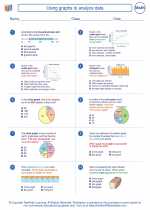Using graphs to analyze data -> straight line
Straight Line
A straight line is a line that extends indefinitely in both directions and has constant slope. It can be represented by the equation y = mx + b, where m is the slope of the line and b is the y-intercept.
Equation of a Straight Line
The general equation of a straight line is given by:
y = mx + b
Where:
Finding the Slope
The slope (m) of a straight line can be found using the formula:
m = (y2 - y1) / (x2 - x1)
Where (x1, y1) and (x2, y2) are two points on the line.
Graphing a Straight Line
To graph a straight line with equation y = mx + b, you can use the y-intercept (0, b) as the starting point, and then use the slope to find additional points on the line. Alternatively, you can rearrange the equation to find x- and y-intercepts, and then plot these points to graph the line.
Study Guide
When studying straight lines, it's important to understand the following key concepts:
- The equation of a straight line (y = mx + b)
- How to find the slope of a line using two points
- Graphing a straight line using the slope and y-intercept
- Finding x- and y-intercepts of a line
- Understanding the relationship between the equation of a line and its graphical representation
Practice solving problems involving the equation of a straight line, finding its slope, and graphing it on the coordinate plane. Additionally, familiarize yourself with different forms of the equation of a line, such as standard form and point-slope form.
Understanding the concept of a straight line is crucial for various topics in mathematics, including linear equations, slope-intercept form, and coordinate geometry.
Remember to seek help from your teacher or tutor if you encounter difficulties and make use of online resources such as interactive graphing tools to visualize and explore straight lines.
Good luck with your studies!
[Straight Line] Related Worksheets and Study Guides:
.◂Math Worksheets and Study Guides Eighth Grade. Using graphs to analyze data

 Worksheet/Answer key
Worksheet/Answer key
 Worksheet/Answer key
Worksheet/Answer key
 Worksheet/Answer key
Worksheet/Answer key
 Worksheet/Answer key
Worksheet/Answer key
 Worksheet/Answer key
Worksheet/Answer key
 Worksheet/Answer key
Worksheet/Answer key
 Worksheet/Answer key
Worksheet/Answer key
